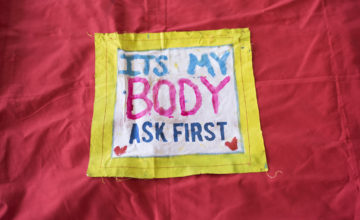
According to Wikipedia, the Fifty Shades of Grey series “has sold over 100 million copies worldwide and been translated into 52 languages, and set a record in the United Kingdom as the fastest-selling paperback of all time.” Not only has it introduced many people to the world of kink, it’s given them a lesson in how not to write. And if a lack of literary merit didn’t slow down sales, well, at least people can learn about the elements of style while being turned on by the elements of sadomasochism.
1. Avoid repetition of words and phrases.
When Ana first meets Christian Grey, she thinks she spots a “ghost of a smile” in his expression. That’s a nice, descriptive way of putting it — it’s easy for the reader to imagine. The problem is, James uses the same exact phrasing only a few pages later, for the same character. And that’s not the last we hear the term “ghost of a smile,” either — it pops up a few more times in the first book. Using something so specific again and again just comes across as lazy.
2. Use adverbs sparingly.
Anastasia Steele never met an adverb she didn’t like, especially when it’s modifying the way she or another character speaks: “I mumble almost inarticulately”; “I murmur apologetically”; “he murmurs softly.” (For painfully excessive use of the word “murmur” throughout Fifty, see rule #1).
3. Don’t use substitutes for the verb “said.”
The Fifty Shades characters rarely just “say” something, they whisper it, they breathe it, they moan it, they mumble it, they murmur it, ad nauseum (see rule #2, and then rule #1). One of Elmore Leonard’s 10 Rules on Writing is this:
Never use a verb other than “said” to carry dialogue. The line of dialogue belongs to the character; the verb is the writer sticking his nose in. But “said” is far less intrusive than “grumbled,” “gasped,” “cautioned,” “lied.” I once noticed Mary McCarthy ending a line of dialogue with “she asseverated” and had to stop reading and go to the dictionary.
4. Be accurate.
There is such a thing as creative license, but E.L. James’s should be revoked. Like driving, creative license is not a right, but a privilege, and should be used responsibly and with the utmost care. For example, the author creatively personifies Ana’s internal struggles over various situations as two polar-opposite people living in her head: a sex-loving, open-minded, free-spirited, back-flipping “Inner Goddess” and a careful, cautious, judgmental worrier called her “Subconscious.” Cute, but what Alanis Morissette did to the word “ironic,” E.L. does to the word “subconscious.” To quote Inigo Montoya from The Princess Bride: “You keep using that word. I do not think it means what you think it means.” If it were truly Ana’s subconscious guiding her, Ana would not be aware of her — that’s what the whole “sub” part of that word means: not conscious! Similarly, there are a ton of British anachronisms in a story about American characters living in American cities with nary a funny Mancunian sidekick to rub off on them. James even includes an apology at the end of the third book for including a scene so preposterous that it defies all logic and law — that’s when you know you’ve abused your creative license.
5. Don’t worry about the rules of writing.
E.L. James didn’t, and look where that got her: laughing all the way to the bank! The most important thing is just sitting down and actually writing. As long as you do that — ideally with passion and conviction — then there’s a chance (albeit small) that you can ignore rules 1 through 4 above and still be a success.
If you liked Fifty Shades (despite the writing), you’ll love 150 Shades of Play, our how-to companion piece to the popular trilogy!






















Ha ha ha! We can’t stop, we won’t stop! Don’t worry Ralphie, just a couple more days of this and we’ll move on…to counting down to the sequel! Just kidding — we promise we’ll take a break soon. xo
AAAUUUGGGGHHHH! Make it stop, please, make it stop. Enough with the 50 Shades of Grey